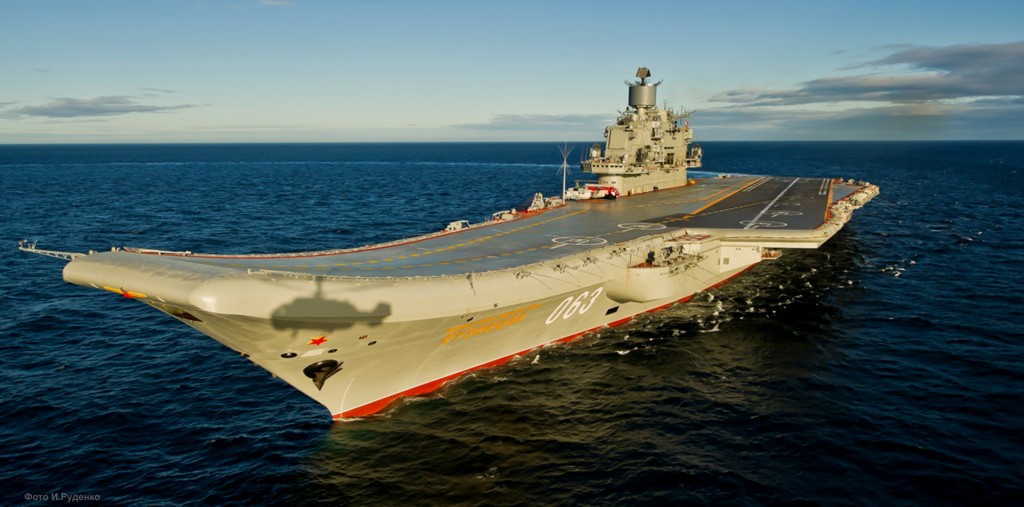 Brandon Turbeville
Brandon TurbevilleActivist Post
May 20, 2016
After the small draw down of Russian troops and aircraft from Syria, the Western media could not contain itself from making claims that the Russians were running scared from their battle with ISIS, despite the fact that the Russian-Syrian alliance had done more to destroy the group in weeks than the U.S. had done in years.
But, while the Russian draw down was itself limited and merely a change in strategy after the initial phase of Russian involvement had been completed, it appears that Russia is now ordering another round of military equipment to Syria.
This time, instead of committing planes and personnel to land bases inside Syria, Russia is sending its aircraft carrier, the Admiral Kuznetsov, to the Meditteranean.
VoltaireNet describes the capabilities of the carrier by writing:
The aircraft-carrier Admiral Kuznetsov (Projet 1143) is driven by gas turbines, has a displacement of 65,000 tonnes, and was launched in December 1990 at naval shipyard n° 444 South at Nikolaev, which was then in the Soviet Republic of Ukraine. It was built to carry between 52 to 55 planes and helicopters. The Admiral Kuznetsov is armed with eight AK-630-type AA artillery systems (2x30mm), eighteen 3K95 Kinzhal-type AA missile launchers, twelve ship-to-ship P-700 Granit missile launchers (range of 620 km, speed Mach 2,5) and two UDAW-1 anti-submarine missile launchers.
The Minister of Defence for the Russian Federation has declared that the completion of repairs for the aircraft-carrier has been advanced to the 1st July 2016. This is why it will not carry only MiG-29 K/KUB, but will also keep some Su-33. Its new configuration will include twelve Su-33 multi-role aircraft, twenty-eight multi-role MiG 29 K/KUB, four Su-25UTG/UBP training and ground attack planes, and eight Ka-27 anti-submarine combat helicopters.
The Su-33 and MiG-29 K/KUB taking off from the aircraft-carrier will only be armed with 30% to 40% of their potential maximum load of arms and fuel (6-9 tonnes). However, this restriction will not prevent them from having the same effect on their targets as the Su-24 and Su-34 bombers which operated in Syria. The Su-24 and Su-34 were each armed with two 250 kg KAB-250 S/LG bombs or two 500 kg KAB-500 L/Kr or KAB-1500 L/Kr bombs, all guided by laser, camera or GPS, or two Kh-29 L/T and Kh-25T-type air-ground missiles, guided by laser or camera. Conceived for hunting missions, the Su-33 and MiG-29 K/KUB will also carry short and medium-range air-air missiles.
The small Russian aircraft-carrier is enough to damage the jihadists operating in Syria, who would be unable to fight back, and would have the same effect as one of the 11 nuclear-powered US aircraft-carriers which have a displacement of more than 100,000 tonnes, with more than seventy-eight planes on board (F/A-18E/F, EA-18G, E-2), and twelve SH-60F helicopters. The Admiral Kuznetsov is not the only aircraft-carrier which can operate with the MiG-29 K/KUB. The old Russian aircraft-carrier Admiral Gorskov, with a displacement of 43,000 tonnes, was rebuilt and modernised in the shipyards of Severodvinsk, and was endowed to the Indian Navy in 2014 under the name of Vikramaditya. It carries only thirty-six planes – twenty-six 26 MiG-29 K/KUB and ten Kamov Ka-28/31 helicopters.
This is not the first report of the Russian carrier heading to the Meditteranean. In early April, it was reported by TASS which cited Russian military sources who said that the Admiral Kuznetsov would be heading to lead the naval group there later in the summer of 2016. The report stated,
The Admiral Kuznetsov heavy aircraft carrier of the Russian Navy in autumn will arrive in the eastern part of the Mediterranean Sea, its aviation grouping will include fighters Sukhoi Su-33 (Flanker-D) and Mikoyan MiG-29K (NATO reporting name: Fulcrum-D), a source told TASS on Saturday.
MiG-29K/KUB fighters were tested at the Admiral Kuznetsov back in 2009, but since then they have not been deployed there on a permanent base.
"According to plans of the General Staff of the Russian Armed Forces, the Admiral Kuznetsov in September-October will enter the Mediterranean Sea, where it will become a flagship of the Russian Navy's grouping," the source said. "The aircraft carrier will have on board a mixed group of deck jets Sukhoi Su-33, Su-25UTG and Mikoyan MiG-29K."
During the months before the campaign, the jets’ crews "will practice skills of takeoff and landing on the carrier deck at ground training facilities in Saki (Crimea) and Yeisk (shore of the Azov Sea)," the source added.
On March 5, a high-ranking official at the Russian Navy told TASS the Admiral Kuznetsov in summer may go to the Mediterranean Sea. "This summer, we plan the Admiral Kuznetsov's campaign in the Mediterranean Sea, where it will lead the Navy group in that region," the source said.Reports from both Russian military sources cited by TASS and those published by VoltaireNet seem to lend corroboration to the idea of the carrier heading to the Syrian coast toward the end of summer.
Brandon Turbeville – article archive here – is the author of seven books, Codex Alimentarius — The End of Health Freedom, 7 Real Conspiracies, Five Sense Solutions and Dispatches From a Dissident, volume 1 andvolume 2, The Road to Damascus: The Anglo-American Assault on Syria, and The Difference it Makes: 36 Reasons Why Hillary Clinton Should Never Be President. Turbeville has published over 650 articles on a wide variety of subjects including health, economics, government corruption, and civil liberties. Brandon Turbeville’s radio show Truth on The Tracks can be found every Monday night 9 pm EST at UCYTV. His website is BrandonTurbeville.com He is available for radio and TV interviews. Please contact activistpost (at) gmail.com.
This article may be freely shared in part or in full with author attribution and source link.
No comments:
Post a Comment
Note: Only a member of this blog may post a comment.